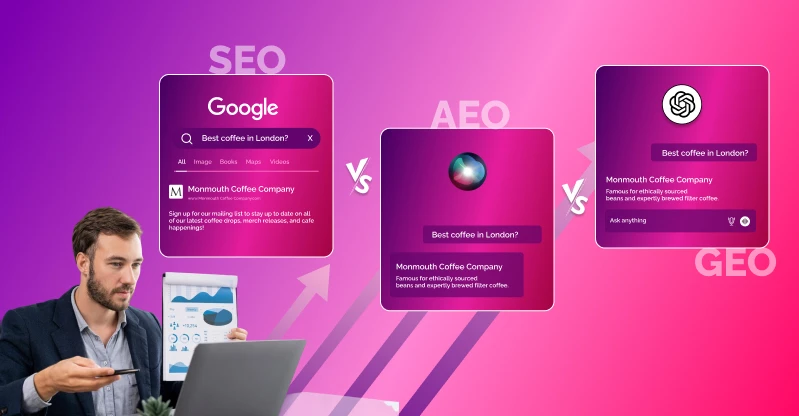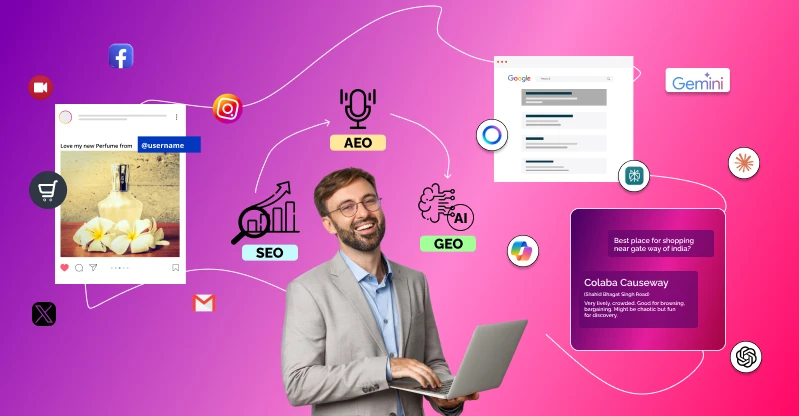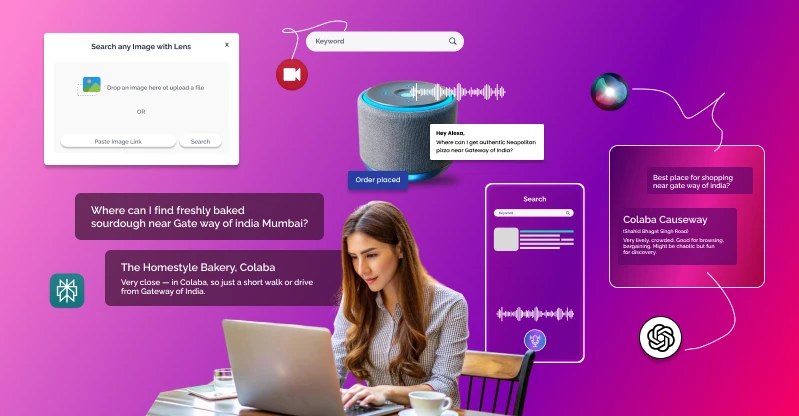SEO vs. GEO vs. AEO: The Ultimate 2026 Guide to Ranking on Everything

Today, consumers search, discover, and interact with brands online in new and creative ways. By 2026, brands will need to deal with an augmented reality that is more personalized and data-driven, where SEO alone will no longer suffice to reach the right customers.
Artificial intelligence (AI) enters the market here, with Generative Engine Optimization (GEO) and Answer Engine Optimization (AEO) at the forefront, the Visibility Rules have been irrevocably overhauled.
Traditional search engines like Google continue to dominate, but no longer the exclusive route. AI-crafted synopsis is rendered by generative search engines like Google’s Search Generative Experience (SGE), Perplexity AI, and You.com.
On the other hand, conversational AI tools like ChatGPT, Bing Copilot, and AI assistants are “answer engines” with customers getting direct answers without links.
This emerging phenomenon demands companies adopt a three-pronged approach: SEO to appear in classic SERPs, GEO to appear in AI-bred abridgements, and AEO to get quoted as an authoritative source in immediate AI answers.
This comprehensive guide discusses what every optimization technique involves, why companies require all three, what the future of SEO looks like, and how to future-proof your digital reputation in 2026 and beyond.
What is SEO?
SEO or Search Engine Optimization is the art of achieving the top-most rank for a website on search engine result pages (SERPs). It has been the backbone of Internet marketing.
SEO can be wide-ranging under four large umbrellas:
Technical SEO
Technical SEO is an important part of your brand, as it takes care of the technical aspects of your website. From making your page faster, ensure it’s optimized for mobile and associated with better Schema to ensure a better index for your webpage.
On-page SEO
On-page SEO is the most effective and widely used tool. It helps your brands to grow their performance by optimizing keywords. With this tool, you can optimize the title, meta description, headers, and content for better reach and visibility.
Off-Page SEO
It is used to boost backlinks from high-authority websites and boost brand mentions to improve brand authority.
Content SEO
This is the part of SEO that involves optimization of any kind of content, whether it is Articles, guides, videos, or product pages, answering the customer’s queries.
Why SEO Still Matters?
Despite all the development of AI-based search experiences, old-fashioned search queries are still huge. Google receives more than 8.5 billion searches every day, and most of them are transactional or local.
Phrases such as “coffee shops around me” or “best Shopify SEO agency USA” are being replied to primarily by old-school SERPs.
Without SEO, companies have no idea about these types of searches, which are the most converting searches.
What is GEO?
Generative Engine Optimization (GEO) is optimization for generative search engines powered by AI, like Google SGE, Perplexity, and You.com.
Conventional search engines return a list of ranked links, but generative engines combine multiple sources into one answer. Your mission in GEO is to have your content included in that AI-generated summary.
Key GEO Elements
- Semantic Content: AI engines seek context and meaning rather than keywords. For instance, a site that describes “how AI software improves Shopify stores in New York” must link words like analytics, automation, customer experience, and revenue growth.
- Structured Data: Schema markup and metadata inform AI about your site. Including product schema, FAQs, and reviews increase your chances of being referenced.
- Long-Tail Optimization: Users pose natural questions to generative machines such as, “What is the best CRM for small businesses in the USA?” GEO targets intent-based conversational queries.
- Sources of Trust: Generative machines will indeed consider credibility. Content referred with references, case studies, and expert remarks will be picked up.
Why GEO Matters?
Being Included in AI-Generated Summaries
Without GEO, even good content goes unnoticed. Optimization for generation systems means that your brand and content become prominent in AI digests with more chances of being cited or quoted in user question answers.
Brand Visibility Outside of SERPs
Whereas SEO is focused on link ranking on search engine results pages, GEO gets your content visible as part of AI-curated answers in a way that you receive visibility wherever users are looking more and more for instant information. That is, your brand engages with users even before someone clicks on any link.
Creates Credibility and Authority
Generative AI prefers content that has been taken from real, reputable sources. Companies whose companies give contextually dense, correct, and formatted content on a regular schedule are most likely to find themselves included in AI summaries, making your company the go-to trusted source in your industry.

Enables enterprise-grade multi-format content strategy
GEO invites brands to produce styled, semantic, and multi-type content blog posts, guides, infographics, videos on which AI can more easily synthesize. This maximizes all-around engagement and puts your content in improved AI vision.
Future-Proof Digital Marketing Efforts
As generative AI is made the default search layer, GEO guarantees that your content is still available even when user behavior drifts away from the traditional clicks and towards AI-curated suggestions. Companies that neglect GEO are hit with declining visibility in an increasingly AI-driven ecosystem.
What is AEO?
Answer Engine Optimization (AEO) is concerned with AI-driven answer engines like ChatGPT, Bing Copilot, and voice assistants (like Siri or Alexa). These websites don’t present users with a list of links instead, they provide one, chatty answer.
How AEO Works
AEO is all about creating content that AI will identify as authoritative and concise. It loves FAQ-type, schema-supported, and context-based answers.
AEO Tactics
Add FAQ Sections
Nowadays, customers are more conscious about the content, and specifically the FAQ’s in the world of AI. With the help of well-written FAQ sections, you can ensure pre-written responses so that it can be easily visible in the AI systems. When writing an FAQ, it needs to be remembered that each question is correct and concise so that it can be useful for the intended users’ queries.
Writing Concise, AI-Friendly Sentences
AI answer engines love content that can be directly pulled into answers. The better segregation of complex concepts can make it better for the users. It needs to be short, meaningful, and no thin content is acceptable.
Using long paragraphs can be difficult for users to understand, and filler words and overstuffed keywords need to be avoided for a better outcome.
Establish Brand Authority
AI algorithms, such as content from a source authority and trustworthiness. Build authority by including expert authorship with credentials.
Including reviews, testimonials, or case studies
Backlinking from authoritative websites and citation of data.
Use Schema Markup
Using a schema is the most appropriate factor for ensuring better outcomes. Therefore, while adding schema, the need for structured data such as useful FAQ’s, product schema and article schema is essential. It will help to understand the context by the AI tool for delivering and sharing direct answers to the end-customers.
Highlight Contextual Relevance
AI processors rank the answers with regard to the extent to which the content reflects the user’s intention. Keywords should be naturally used, but stress should be laid on semantics and readability rather than repetition.
Why AEO Matters
Direct Brand Visibility
When AI assigns the origin of a response to your brand, you’re an instant authority. No users might visit your site, but they know your brand is authoritative and knowledgeable.
Shaping Decisions at the Point of Need
AI provides answers at the moment when users ask questions. Suppose a customer inquires about “Best Shopify apps for New York small businesses?” A presence in that answer has the direct power to make a difference in the decision-making process of the customer.
SEO vs. GEO vs. AEO: Key Differences
| Attribute | SEO (Search Engine Optimization) |
GEO (Generative Engine Optimization) |
AEO (Answer Engine Optimization) |
| Focus | Ranking in SERPs via keywords, links, and authority | Being featured by AI-generated summaries | Being featured in AI-powered direct answers |
| User Experience | Users click links to learn | Users are given AI-curated multi-source responses | Users are given single, conversational answers |
| Strategy | Keywords, backlinks, metadata, UX | Context, semantics, structured data | FAQs, short content, schema |
| Objective | Drive organic traffic | Exposure in generative AI abstracts | Establish brand authority in response engines |
Typical Problems and Errors
- SEO Relying: Companies think that showing up on Google SERPs would suffice. But with AI abstractions layered on top of it, visibility is gone without GEO and AEO.
- Schema Abandonment: No structured data means your content can’t be properly understood by AI.
- Generic Content Generation: AI likes short, context-sensitive content. Slim, keyword-laden blog articles won’t work.
- No Continuous Optimization: Search algorithms and AI keep changing continuously. Those companies which “set and forget” are left way behind.
How Agencies Can Help to Implement
SEO, GEO, and AEO expertise has agencies that perform full-stack optimization. With well-known agencies, businesses can benefit by:
- Deployment of structured data and schema for AI readability.
- Creation of multi-format content, FAQs, product pages, blogs which are SEO, GEO, and AEO compliant.
- Providing answer engine optimization consulting to get brands ready for AI-first search.
- Platform integrations managed on Magento, Shopify Plus, BigCommerce, and headless commerce.
- Providing ongoing monitoring and optimization as the algorithms shift.
- The integrated strategy stays ahead of the curve regardless of where customers are looking.

Future of SEO, GEO, and AEO
The three optimization models in the future will change but be interdependent.
- SEO: Old-fashioned SEO will not disappear; it will merely become more technical and credible. Site health, E-E-A-T, and Core Web Vitals will be important.
- GEO: Generative AI as the default search layer will lead to GEO being the highest priority. Content will have to be about meaning, authority, and structure.
- AEO: With answer engines embedded in mobile phones, smart speakers, and eCommerce sites, AEO will rewrite discovery rules. Companies need to get ready for a world where customers never click a link they just ask and get.
Together, these trends create the future digital visibility. Companies that embrace them today will win; the late adopters will become extinct.
Conclusion
2026’s virtual world calls for even more from traditional SEO. Generative Engine Optimization and Answer Engine Optimization are now prerequisite needs for businesses to stay visible, top-of-mind, and in the forefront.
By integrating all three, SEO for search engine result pages, GEO for abstracts created by artificial intelligence, and AEO for question-and-answer structured answers brands are able to make sure that they are visible wherever their customers are.
To ensure success in this competitive era, make sure you are not behind algorithms and changing consumer trends. Connect with an eCommerce expert to execute the right platform and strategies to grow your brand.
FAQs
 How is Magneto IT Solutions SEO, GEO, and AEO optimizing eCommerce websites?
How is Magneto IT Solutions SEO, GEO, and AEO optimizing eCommerce websites?
We optimize by utilizing structured data, semantic optimization, and AI monitoring for the search engine, generative engine, and answer engine.
 How is your SEO different from your AEO services?
How is your SEO different from your AEO services?
SEO aims at SERP ranking, whereas AEO includes your business in conversational AI answers such as ChatGPT or Bing Copilot.
 Do you optimize e-commerce websites for generative search engines such as Google SGE or Perplexity?
Do you optimize e-commerce websites for generative search engines such as Google SGE or Perplexity?
Yes, we implement GEO approaches with a focus on context, semantics, and schema for AI-bundled answers.
 How do you leverage structured data, schema, and FAQs for answer engine rankings?
How do you leverage structured data, schema, and FAQs for answer engine rankings?
By adding schema markup and FAQ data, you are AI-optimizing your website for answer and generative search engines.
 Does support multilingual or region-based SEO/GEO strategies for global ecommerce businesses?
Does support multilingual or region-based SEO/GEO strategies for global ecommerce businesses?
Yes, we customize campaigns according to regional languages, shopping behaviors, and platforms to serve the maximum audience.
 Do you implement GEO strategies on Magento, Shopify Plus, BigCommerce, and headless commerce implementations?
Do you implement GEO strategies on Magento, Shopify Plus, BigCommerce, and headless commerce implementations?
Yes. Our competencies span multiple platforms, facilitating complete optimization across ecosystems.
 In what ways do your CRO and digital marketing services overlap with SEO, GEO, and AEO?
In what ways do your CRO and digital marketing services overlap with SEO, GEO, and AEO?
We integrate conversion rate optimization with SEO and AI methodologies to push traffic into quantifiable growth.
 Do you provide ongoing monitoring and optimization for adaptive search engines and AI algorithms?
Do you provide ongoing monitoring and optimization for adaptive search engines and AI algorithms?
Yes, we offer regular reporting and optimization to remain ahead of evolving SEO, GEO, and AEO trends.





